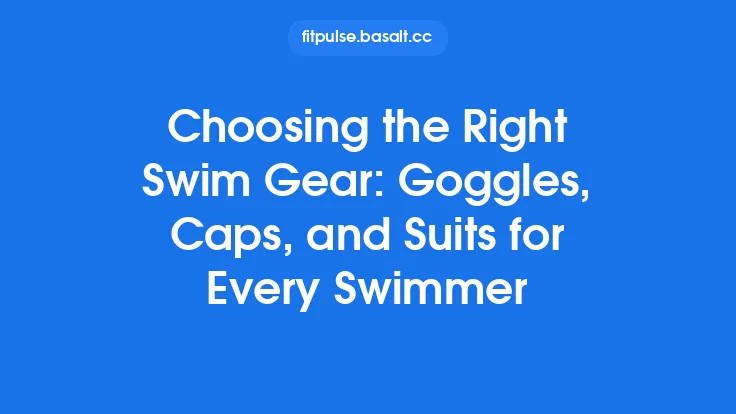Choosing the right compression gear is more than a matter of personal style; it’s a strategic decision that can enhance performance, support specific training adaptations, and protect you from unnecessary strain. With a market flooded with options—tights, sleeves, tops, shorts, and more—understanding how each piece aligns with your individual goals is essential. Below is a comprehensive guide to help you navigate the selection process, ensuring that the garments you invest in truly serve the purpose you need.
Understanding Your Training Objectives
Before you even glance at product listings, clarify what you want to achieve. Different training goals demand distinct compression characteristics:
| Training Goal | Primary Need | Typical Compression Focus |
|---|---|---|
| Strength & Power | Muscle support during heavy lifts, reduced vibration | High‑compression sleeves for joints (e.g., knee, elbow) and tight‑fitting shorts/tights |
| Endurance (Running, Cycling, Rowing) | Sustained muscle stability, reduced fatigue | Moderate compression throughout the limb to aid circulation over long periods |
| Speed & Agility | Freedom of movement, quick muscle recovery between bursts | Light to moderate compression that doesn’t restrict range of motion |
| Rehabilitation / Return‑to‑Play | Controlled support, gradual re‑introduction of load | Targeted, graduated compression (often prescribed by a professional) |
| General Conditioning / Cross‑Training | Versatile support across multiple muscle groups | Full‑body tights or compression shirts that provide uniform pressure |
By mapping your primary training focus to the type of support you need, you can narrow down the categories of garments that will be most beneficial.
Types of Compression Garments and Their Typical Uses
| Garment Type | Coverage | Common Applications |
|---|---|---|
| Compression Shorts/Tights | Hip to mid‑thigh (shorts) or full leg (tights) | Weightlifting, sprinting, HIIT, sports requiring low‑profile support |
| Calf Sleeves | Lower leg, from ankle to just below the knee | Running, cycling, basketball—helps stabilize calf muscles |
| Arm Sleeves | Upper arm to wrist | Weight training, rowing, sports with repetitive arm motion |
| Compression Shirts/Tank Tops | Torso, shoulders, arms | CrossFit, gymnastics, any activity where core stability is key |
| Hip & Glute Wraps | Pelvic region | Powerlifting, sprinting, sports demanding strong hip drive |
| Full‑Body Compression Suits | Entire torso, limbs | Elite endurance events, multi‑day training camps where uniform support is desired |
Each garment type offers a different balance of coverage, pressure distribution, and mobility. Selecting the right style hinges on which muscle groups you need the most assistance with during your specific workouts.
Matching Compression Levels to Specific Goals
Compression is often quantified by pressure (measured in millimeters of mercury, mmHg). While the exact numbers can vary by brand, a general framework helps you align pressure with intent:
| Pressure Range | Approximate mmHg | Ideal Use Cases |
|---|---|---|
| Low (5–10 mmHg) | Light, barely perceptible | Warm‑up, low‑intensity cardio, daily wear |
| Moderate (10–20 mmHg) | Noticeable support without restriction | Endurance training, moderate‑intensity strength sessions |
| High (20–30 mmHg) | Firm, supportive feel | Heavy lifting, high‑impact sports, targeted rehab |
For most athletes, moderate compression strikes the best balance between support and freedom of movement. High compression is valuable for specific scenarios—such as heavy squats or post‑injury stabilization—but may feel restrictive during longer aerobic sessions.
Evaluating Pressure Ratings and What They Mean
Manufacturers sometimes list pressure ratings, but the numbers can be inconsistent due to differing testing methods. Here’s how to interpret them responsibly:
- Look for Independent Verification – Brands that provide third‑party testing (e.g., ISO‑validated pressure mapping) are generally more trustworthy.
- Check the Pressure Distribution – Uniform pressure across the garment is preferable; uneven zones can cause discomfort or even impede circulation.
- Consider the Compression Gradient – Even if you’re not focusing on “graduated” compression, a slight decrease in pressure from distal to proximal ends (e.g., ankle to calf) is natural and helps blood flow.
If a product lacks clear pressure data, rely on user feedback and material stretch characteristics to gauge how firm the fit will be.
Material Considerations Beyond Fabric Technology
While the specific fiber blends (nylon, spandex, etc.) are often highlighted, think about the functional attributes they deliver:
- Elastic Recovery – The garment should return to its original shape after stretching. Poor recovery leads to sagging and reduced support over time.
- Breathability – Look for mesh panels or micro‑perforations that allow heat to escape, especially for full‑leg or torso pieces.
- Moisture Management – Even without delving into advanced fabric tech, a good compression garment will wick sweat away from the skin, reducing the risk of chafing.
- Seam Construction – Flat‑lock seams minimize irritation, a crucial factor for long training sessions.
These qualities collectively influence comfort, which directly impacts whether you’ll actually wear the gear consistently.
Fit and Comfort – What to Look For
A well‑fitted compression piece should feel snug but not painful. Keep these practical cues in mind:
- Secure Yet Flexible – The garment should stay in place during dynamic movements without sliding or bunching.
- No Pinching – Edges or seams should not dig into the skin; this is a sign of poor design or inappropriate sizing.
- Range of Motion – Perform a few movement tests (squat, lunge, arm circle) while wearing the gear. You should retain full mobility without feeling overly restricted.
- Skin Sensitivity – If you have a history of dermatitis or allergies, opt for garments labeled hypoallergenic or silicone‑free.
While detailed sizing charts belong to a separate guide, a quick “try‑on” or trial period can reveal whether the fit aligns with your comfort standards.
Durability and Longevity Indicators
Compression garments are an investment; you’ll want them to hold up through countless training cycles. Assess durability by examining:
- Stitch Quality – Reinforced stitching at high‑stress points (e.g., knee seams on tights) prolongs lifespan.
- Elastic Band Integrity – The waistband or cuff should retain tension after repeated stretches. Some brands incorporate dual‑layer elastics for added resilience.
- Abrasion Resistance – Look for reinforced panels in areas prone to friction, such as the inner thigh for cyclists.
- Warranty Terms – A manufacturer’s confidence often shows up in a one‑year or longer warranty covering loss of elasticity.
Choosing gear with these durability cues reduces the need for frequent replacements, offering better long‑term value.
Brand Reputation, Certifications, and Warranty
When navigating a crowded market, brand credibility can be a reliable shortcut:
- Established Sports Brands – Companies with a history in performance apparel often have refined design processes and rigorous testing.
- Medical‑Grade Certifications – Some compression garments carry ISO 9001 (quality management) or ASTM standards, indicating adherence to recognized manufacturing practices.
- Athlete Endorsements vs. Independent Reviews – While athlete sponsorships can signal confidence, independent user reviews provide a more balanced perspective on real‑world performance.
- Warranty Coverage – A clear, hassle‑free warranty signals that the manufacturer stands behind the product’s durability and performance.
Researching these aspects helps you avoid low‑quality knock‑offs that may compromise both comfort and effectiveness.
Cost‑Benefit Analysis – When to Invest More
Higher price points often reflect premium materials, advanced construction, and stronger brand support, but they don’t always guarantee superior performance for every athlete. Consider the following framework:
| Investment Level | Typical Price Range | When It Makes Sense |
|---|---|---|
| Entry‑Level | $20–$40 | Casual gym-goers, occasional training, testing a new garment type |
| Mid‑Tier | $40–$80 | Regular athletes, multi‑disciplinary training, need for reliable durability |
| Premium | $80+ | Elite competitors, sport‑specific demands (e.g., pro cyclists), long‑term daily wear |
If you train intensively (5+ sessions per week) and rely heavily on compression for joint support or muscle stabilization, the mid‑tier to premium range often offers the best balance of performance and longevity. For occasional use, an entry‑level option may suffice.
Sustainable and Ethical Choices
Increasingly, athletes are looking beyond performance to consider the environmental footprint of their gear:
- Recycled Fibers – Some manufacturers incorporate post‑consumer plastic bottles or reclaimed fishing nets into their fabrics, reducing waste.
- Eco‑Friendly Dye Processes – Low‑impact or water‑less dyeing methods lower chemical runoff.
- Fair‑Labor Certifications – Labels such as Fair Trade or WRAP (Worldwide Responsible Accredited Production) indicate ethical manufacturing practices.
Choosing sustainable options not only aligns with personal values but can also lead to higher‑quality materials that retain elasticity longer, as many eco‑focused brands prioritize durability to justify the premium price.
Practical Tips for Testing Gear Before Commitment
- Trial Periods – Many online retailers offer a 30‑day return window. Use this time to wear the garment during a variety of workouts (strength, cardio, mobility) to assess comfort and support.
- Movement Checklist – Perform a quick series of movements: deep squat, overhead press, lateral lunge, and a sprint or high‑knee drill. Note any slipping, pinching, or restriction.
- Layer Compatibility – Try the compression piece under your typical training attire (shorts, leggings, shirts). Ensure it doesn’t create bulk or cause overheating.
- Feedback Loop – If possible, get a second opinion from a training partner or coach who can observe any changes in your movement patterns while you’re wearing the gear.
These hands‑on checks are more reliable than relying solely on product descriptions.
Bringing It All Together
Selecting the right compression gear is a personalized process that blends an understanding of your training objectives with a critical evaluation of garment features. By:
- Defining the specific support you need,
- Matching garment type and pressure level to those needs,
- Scrutinizing material quality, fit, durability, and brand credibility,
- Weighing cost against expected usage, and
- Considering sustainability and ethical production,
you can make an informed purchase that truly enhances your training experience. Remember, the best compression piece is the one that feels like an extension of your body—providing support when you need it, staying comfortable throughout your session, and lasting long enough to justify the investment. With these guidelines in hand, you’re ready to navigate the market confidently and choose the gear that aligns perfectly with your performance goals.




